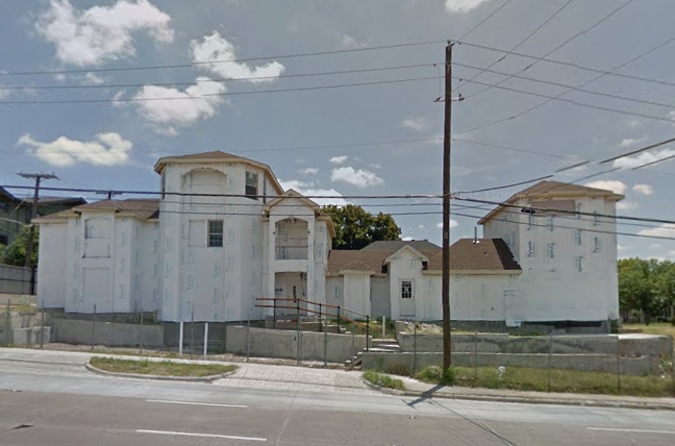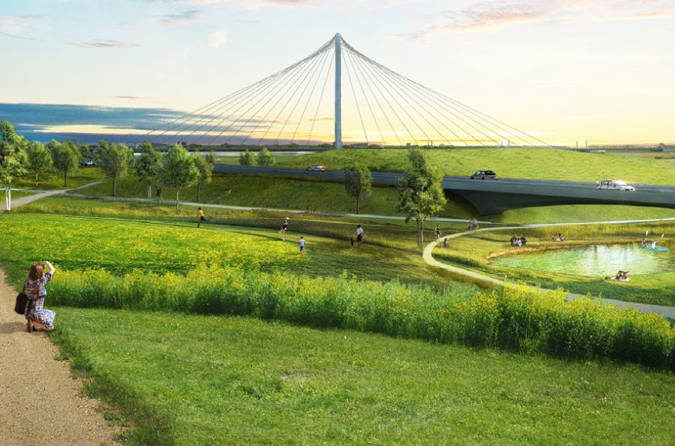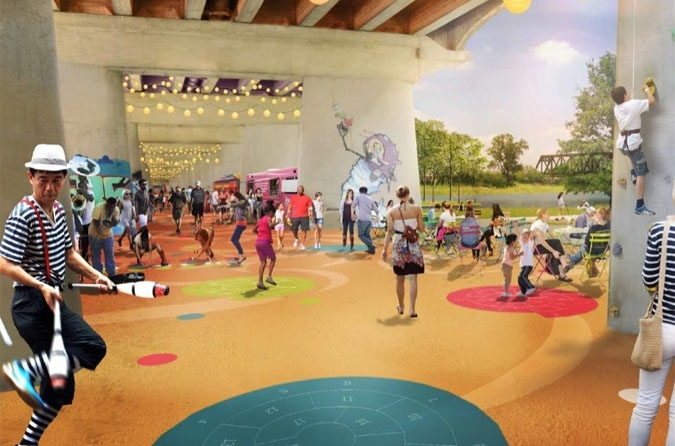
That photo above is a Google maps shot of a house that sits on the corner of Marlborough Ave. and Davis St. in Oak Cliff. It has more or less looked like that for the better part of five years. The house is the ultimate DIY project. As Rachel Stone reported in the Oak Cliff Advocate earlier this year, Ricardo Torres bought the house in 2008 and set about building his dream home. Torres is a crafty guy. He started from scratch with a plan for a two story home. Then he realized that if he added a third story, he could have a downtown view. You know what would also be cool? A game room. So he tacked on one of those, and the house grew like a drawing in a Dr. Seuss book.
Home construction isn’t Torres’ gig. He’s a 34-year-old jeweler, but he knows his way around a hammer. The lot, rezoned as part of the creation of PD 830 (the same zoning change that affected Bishop Arts), was directly next door to his mother’s house. The sky was the limit, and the house was going to be his little piece of paradise – a 5,000 square foot manse he could be proud to say he built with his own two hands.
Torres worked mostly on weekends doing nearly all of the work himself. He took out a home-equity loan on his mother’s house to help finance the project, as well as $20,000 in credit card debt and personal loans. Eventually, it became too much. Costs ran up. Torres couldn’t keep up with the construction timetable. Code violations generated court dates and fines. Now the house now sits unfished, as it has for years. He tried to sell it last year, putting it on the market for $250,000. But an unfinished, highly customized house built by a thirty-something jeweler is worth essentially nothing to anyone besides Ricardo Torres.
I have been thinking about Torres’ house over the past few days while following the latest coverage of the Trinity River Project. If you’re not up to speed, over the weekend Brandon Formby reported on the latest round of renderings of the Trinity Parkway which are supposed to reflect the meandering, scaled-down road suggested by the mayor’s “Dream Team” of urban planners last spring. To the surprise of no one, the road doesn’t yet meander in the same way the Dream Team’s pretty watercolors imagined it. That prompted some orating by council member Scott Griggs at Monday’s meeting of the Dallas City Council’s Trinity River Committee, as well as an column by DMN architecture Mark Lamster, who reminds us that the only thing that meanders when it comes to the Trinity are the promises project backers make to the public.
I’ve been tempted to piggy back on Lamster’s comments, to rage about political duplicity and bureaucratic déjà vu. But instead I can’t stop thinking about Ricardo Torres and how his home is a lot like the Trinity River Project.

Torres’ house and the Trinity River Project both started with a bold and ambitious dream. Both took shape thanks to dedication, hard work, and not a little bit gumption. Both began with an initial vision, followed plans that were adjusted and readjusted, reacting to compromises or new ideas. As each project started to come together, they grew in scale and complexity, buoyed by hope and excitement over how great the finished project could be. We can imagine Torres siting on the roof of his house, tacking on sheeting, stopping to wipe the sweat off his forehead as he eyed the “wow” view of downtown that would one day be his own. This week we listened to city staff describe a new parkway swooping into the floodplain and offering its own “wow” view of downtown.
In the half-constructed state, the dream begins to feel real. But at a certain point, progress also obscures the underlying assumptions that may make finishing the project unfeasible.
For example, let’s take this latest spat over the meandering of the road. The problem with all of the Dream Team’s work is that it was being laid over an existing engineering design that had already been approved by federal authorities. The team of designers told us their new vision could fit into the raised “shelf” that was designed to keep the already designed high-speed toll road dry during our frequent flooding. But this latest round of designs is beginning to show that incorporating the kinds of meanderings imagined by the Dream Team is not as easy – or even as possible – as it was originally stated. Furthermore, the feds still expect that the full-scale road will eventually be built-out. In other words, the engineering is still driving the design of the road. We now want a meandering parkway, but we have already constructed too much of our dream house to signifcantly change the scope and scale of the road.
And it’s not just the road. One thing that should be encouraging about the latest go-round of discussions about the Trinity River Project is the way in which the language around the park component of the plan has changed. In the business-ese that is being used down at city hall, the park is now thought of as the “client” for the parkway and floodway. This is part of the mayor’s reinvigorated push for progress on the park. He believes that it is one thing everyone in Dallas agrees on: we want a great park built in the Trinity floodway.
The problem with the park, however, is the word “park.” It is a word that has been used ambiguously over the years. What kind of park are we trying to build? For decades the phrase has been, “Our Central Park.” We had a vision of a grand urban space, a gathering place, a locus point that could serve as the physical grounding and the metaphoric center of the heart of our city. That metaphor took flight. This Trinity Park could be more than just a green space, it would be the public setting in which the people of Dallas confronted itself, where they city’s civic identity took shape. The park would serve as both a concrete and symbolic bridging of north and south, a civic fulcrum point — not just a park, but a spiritual center, a pastoral agora.
In design, this vision took the form of urban lakes, a white water course, public plazas, sites for pop-up activity, a “water maze,” and other discrete amenities. Overtime, the vision for the lakes shrank, a poorly engineered white water course ruined the river for canoers, the water maze became the butt of ridicule, and the “juggler under the overpass” emerged as a kind of buffo symbol of everything that was incongruous with the vision of the Trinity as a grand urban park. That vision has come to belong to an imaginary future that does not corresponded to the reality of our wild, temperamental, unpredictable, and often very powerful and destructive river.

There is space for a conversation about what kind of park or public amenity the Trinity – and specifically the portion of the Trinity that runs past downtown – should be. But that conversation is largely moot because, just as the toll road is contingent on the existing federally approved engineering of the high-speed version of the road, the construction of the park itself is contingent on the means by which we plan to fund the creation of the park. There is a reason why, over time, the vision for the Trinity Park has come include a laundry list of individual improvements – lakes, plazas, mazes. It’s because we are trying to fund the park with private donations, and the best way to raise private funds is to create “naming opportunities.” You can’t just build a greenspace, you have to create a greenspace filed with stuff people can pay for and then slap their name on.
I’m not being cynical here or dismissing Dallas’ abundant and generous philanthropy, nor am I challenging the motives of either the donors or the dedicated individuals who have been tireless champions of the project over the years. All I’m saying is that the conception of the park as it exists today sets up a situation in which the tail wags the dog. The strategy for “how-to-pay-for” drives the “what-to-pay-for.”
In the years we have been trying to realize the Trinity River Project, like Ricardo Torres, we have kept our eyes firmly fixed on the future skyline view. In the meantime, we’ve lost sight of what we are actually making. In the name of the Trinity River Project, we have ravaged our river. We’ve drained ecologically sensitive ponds and dug-up a Cowboys Stadium-sized pit. We have built trails that are not maintained and continue to permit uses in proximity to the river and forest that are environmental disastrous. The city and county has shown itself incompetent of managing its lands, hiring irresponsible hog hunters and animal-abusing horse park managers, blundering prosecution of companies that dump blood into the river, and pursuing a golf course project that is simultaneously fiscally and environmentally questionable at best. The list goes on.
Now we’re trying to squeeze a kinder gentler road into a federal mandate for a high speed toll road, and we are trying to raise money for lakes, plazas, and other park amenities in the floodplain because the mayor believes that what we can all agree upon is that we want a Trinity River Park.
But I’m not sure the park as it is currently imagined really is the least common denominator of agreement when it comes to the Trinity River. What I believe everyone really wants for Dallas – or at least what no one could come out and say they don’t want for Dallas – is to first and foremost protect and enhance the natural resource that is the Trinity River.
From the beginning of the Trinity River Project – I’m talking way back in the 19th century when we hoped to turn it into a shipping canal – we have tried to shape the river, to change the river, to plan and engineer the river and its floodplain into a form that will serve the city. In the process, we have lost sight of something vitally important. We have failed to do much listening to the river.
This year it has been difficult not to listen to the Trinity River. Record rains reminded us of its cantankerous power. We all saw the flood between the levees, but hike through the forests of South Dallas and you can still see the silt caked on tree trunks six feet high, see branches and trees toppled over concrete paths, and find litter strewn throughout the woods. A swollen Lemmon Lake helped attract spoonbills and ibis from Central America this fall; feral hogs have hollowed out mud pit beds between the tangled brush of the bottomlands. As we spent the year arguing back and forth about traffic engineering, signature parks, and meandering parkways, the natural pageantry of the Trinity has continued to play out, largely out of view and out of mind of those who hold sway over deciding the Trinity’s future.

The Trinity is wilderness at our doorstep, a fecund and dynamic natural wild that runs like a green scar through the glass and concrete civility of 21st century Dallas. Perhaps the reason why the Trinity River Project has been such a long slog is that we have never really come to terms with just what kind of river and natural setting the Trinity River actually is. There’s a good reason why flood control protections make engineering a toll road in the flood plain so difficult and expensive, just as there’s a good reason why it is so difficult and costly to engineer lakes in the wetlands of river that floods and drains and doesn’t hold water. The reason, put simply, is the Trinity River. And like Ricardo Torres’ dream home, while our ideas for what the Trinity are grand and admirable, they ignore an underlying reality that doesn’t correspond to that dream.
We need to stop trying to make the Trinity something other than it is. We need to respect its character and the threats it poses, while thinking about how to open up its subtle beauty. We need to listen to river. Listen to it flood. Listen to it drain. Listen to its ancient geology buried under its silt, and to the birds that make their way through its grasses, trees, and lakes. The river’s ecology suggests its best use is not as an urban park but as a preserve, a place left largely unfettered but opened to the public through the introduction of imaginative, low impact access points. The only meandering going on in the Trinity should be the restored meanders of the river itself. But before we build anything, let’s listen to the river and figure out how to protect it and preserve it.
Dallas likes to think of itself as a “can do” city, and as the Trinity River Project presented problems over the years, this “can do” spirit has deepened our resolve to make it work. But there is an aspect of this “can do” attitude that can feel like a kind of adolescent obstinacy. Even when the evidence suggests that our ideas for the river are wrong headed, we still push forward. We can’t stop now, what a waste of all these years planning and effort that would be!
But the real waste would be not learning from all these years of effort. It would be foolish not to admit that what we have constructed thus far is impossible to finish. If we do that, we’ll end up like Ricardo Torres, the owner of an uninhabitable house. We don’t have to start over, but let’s at least try not to be delusional.



